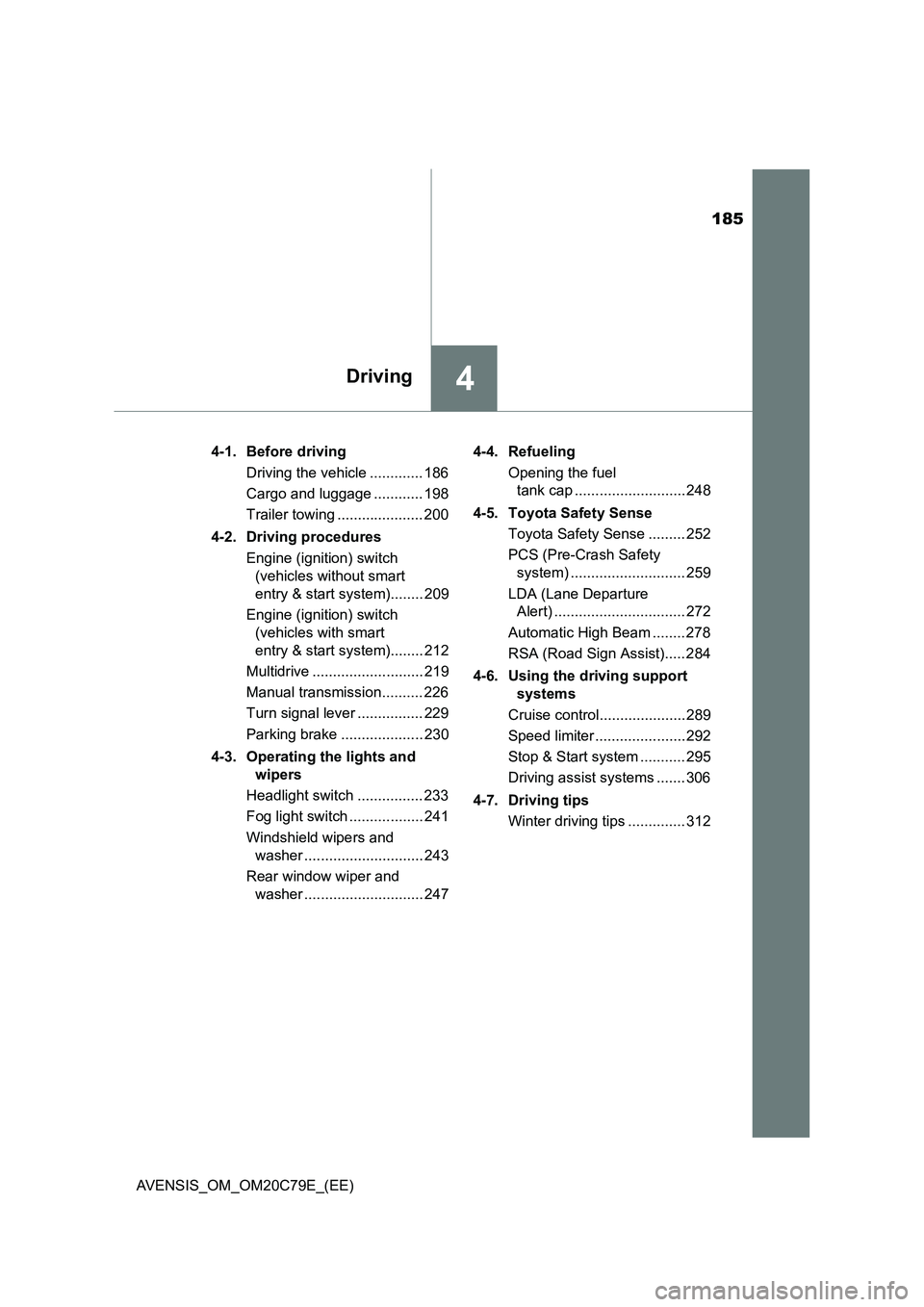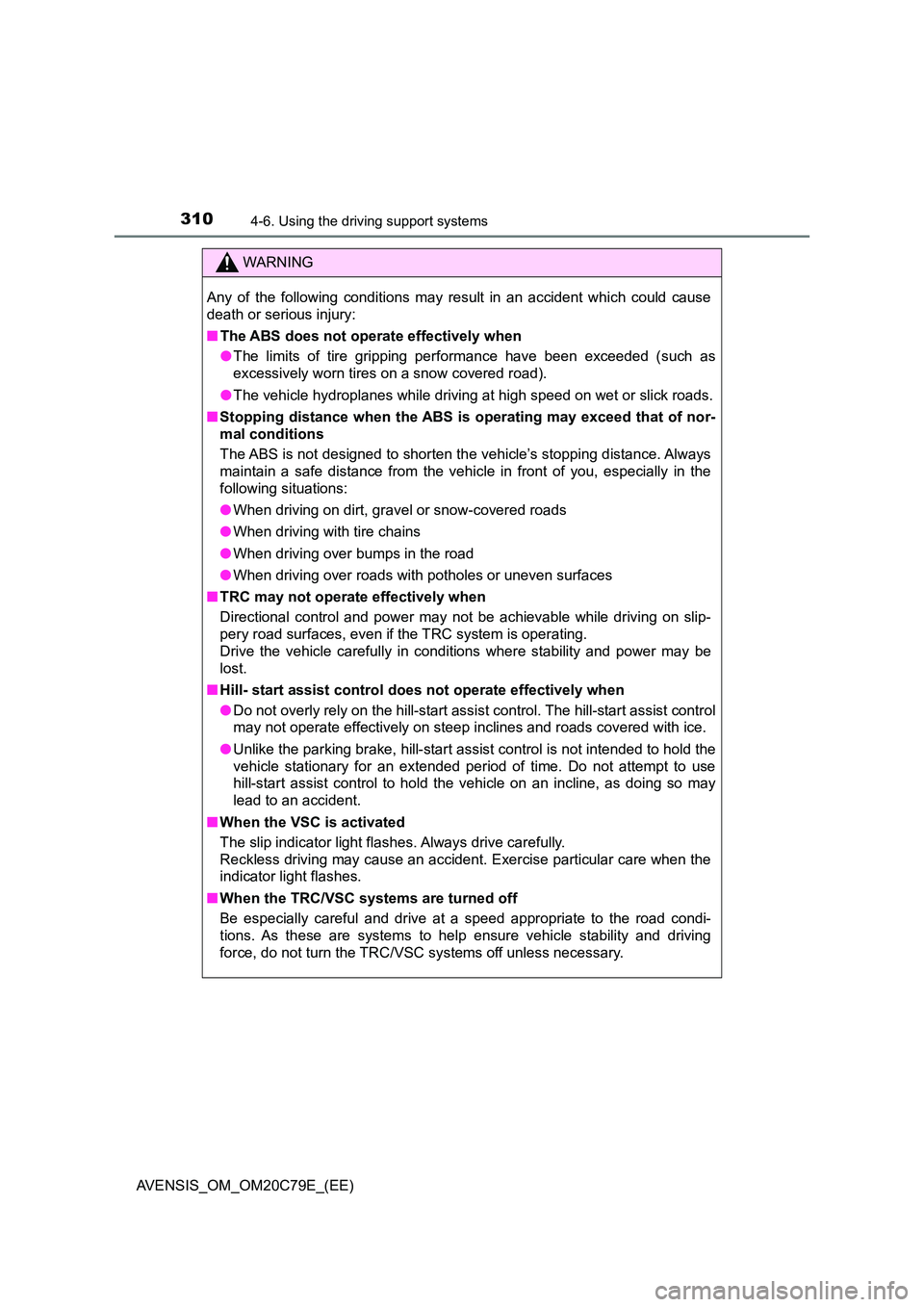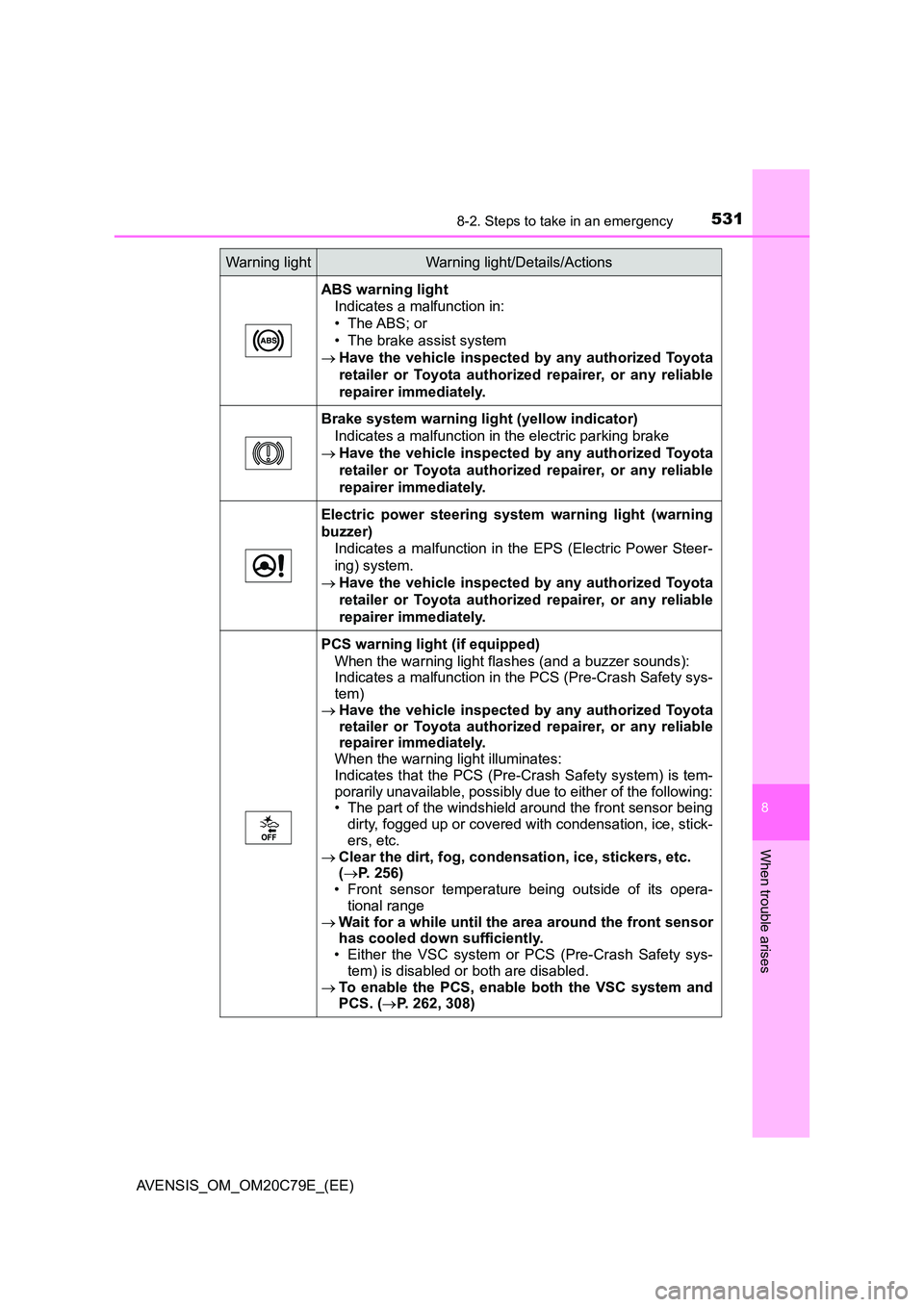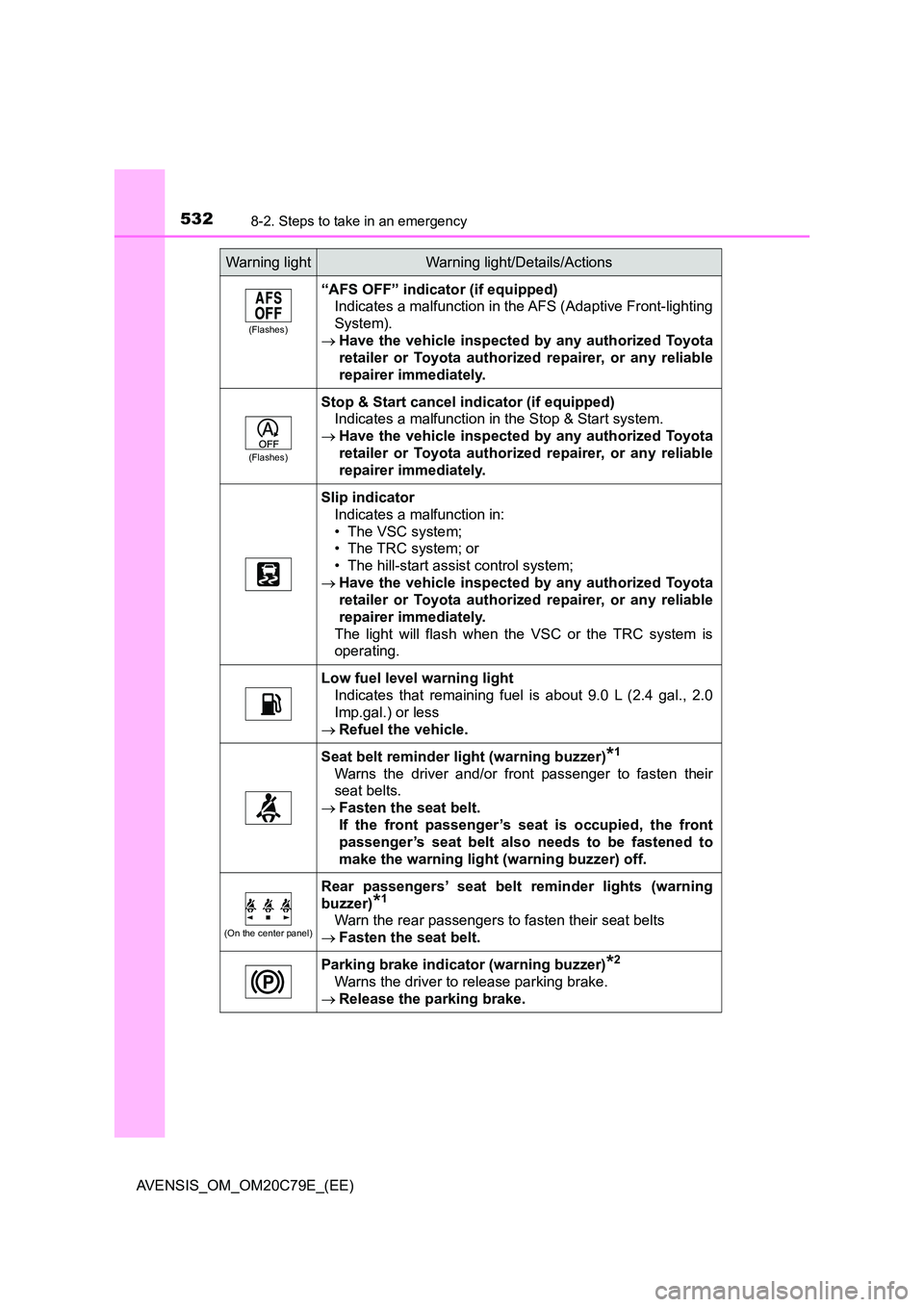2018 TOYOTA AVENSIS park assist
[x] Cancel search: park assistPage 3 of 660

3
1
8
6
5
4
3
2
AVENSIS_OM_OM20C79E_(EE)
9
7
3-4. Adjusting the steering
wheel and mirrors
Steering wheel ...................174
Inside rear view mirror .......176
Outside rear view
mirrors .............................179
3-5. Opening and closing the
windows
Power windows ..................182
4-1. Before driving
Driving the vehicle .............186
Cargo and luggage ............198
Trailer towing .....................200
4-2. Driving procedures
Engine (ignition) switch
(vehicles without smart
entry & start system)........209
Engine (ignition) switch
(vehicles with smart
entry & start system)........212
Multidrive ...........................219
Manual transmission ..........226
Turn signal lever ................229
Parking brake.....................230
4-3. Operating the lights and
wipers
Headlight switch ................ 233
Fog light switch ................. 241
Windshield wipers and
washer ............................ 243
Rear window wiper and
washer ............................ 247
4-4. Refueling
Opening the fuel
tank cap .......................... 248
4-5. Toyota Safety Sense
Toyota Safety Sense ......... 252
PCS (Pre-Crash Safety
system) ........................... 259
LDA (Lane Departure
Alert) ............................... 272
Automatic High Beam ....... 278
RSA (Road Sign Assist) .... 284
4-6. Using the driving support
systems
Cruise control .................... 289
Speed limiter ..................... 292
Stop & Start system .......... 295
Driving assist systems....... 306
4-7. Driving tips
Winter driving tips.............. 312
4Driving
Page 185 of 660

185
4Driving
AVENSIS_OM_OM20C79E_(EE)4-1. Before driving
Driving the vehicle ............. 186
Cargo and luggage ............ 198
Trailer towing ..................... 200
4-2. Driving procedures
Engine (ignition) switch
(vehicles without smart
entry & start system)........ 209
Engine (ignition) switch
(vehicles with smart
entry & start system)........ 212
Multidrive ........................... 219
Manual transmission.......... 226
Turn signal lever ................ 229
Parking brake .................... 230
4-3. Operating the lights and
wipers
Headlight switch ................ 233
Fog light switch .................. 241
Windshield wipers and
washer ............................. 243
Rear window wiper and
washer ............................. 2474-4. Refueling
Opening the fuel
tank cap ........................... 248
4-5. Toyota Safety Sense
Toyota Safety Sense ......... 252
PCS (Pre-Crash Safety
system) ............................ 259
LDA (Lane Departure
Alert) ................................ 272
Automatic High Beam ........ 278
RSA (Road Sign Assist)..... 284
4-6. Using the driving support
systems
Cruise control..................... 289
Speed limiter ...................... 292
Stop & Start system ........... 295
Driving assist systems ....... 306
4-7. Driving tips
Winter driving tips .............. 312
Page 188 of 660

1884-1. Before driving
AVENSIS_OM_OM20C79E_(EE)
Multidrive
Make sure that the parking brake is set and shift the shift lever to D
or M.
Gently depress the accelerator pedal.
Release the parking brake.
Manual transmission
With the parking brake set and the clutch pedal fully depressed,
shift the shift lever to 1.
Lightly depress the accelerator pedal at the same time as gradually
releasing the clutch pedal.
The parking brake will automatically release. (P. 230)
■When starting off on a uphill
The hill-start assist control is available. (P. 306)
■Driving in the rain
●Drive carefully when it is raining, because visibility will be reduced, the win-
dows may become fogged-up, and the road will be slippery.
●Drive carefully when it starts to rain, because the road surface will be espe-
cially slippery.
●Refrain from high speeds when driving on an expressway in the rain,
because there may be a layer of water between the tires and the road sur-
face, preventing the steering and brakes from operating properly.
■Engine speed while driving (vehicles with Multidrive)
In the following conditions, the engine speed may become high while driving.
This is due to automatic up-shifting control or down-shifting implementation to
meet driving conditions. It does not indicate sudden acceleration.
●The vehicle is judged to be driving uphill or downhill
●When the accelerator pedal is released
●When the brake pedal is depressed while sport mode is selected.
●When the vehicle suddenly decelerates because the brake pedal is
depressed
Starting off on a steep uphill
1
2
3
1
2
3
Page 195 of 660

1954-1. Before driving
4
Driving
AVENSIS_OM_OM20C79E_(EE)
WARNING
Observe the following precautions.
Failure to do so may result in death or serious injury.
■ When taking a nap in the vehicle
Always turn the engine off.
Otherwise, if you accidentally move the shift lever or depress the accelera-
tor pedal, this could cause an accident or fire due to engine overheating.
Additionally, if the vehicle is parked in a poorly ventilated area, exhaust
gases may collect and enter the vehicle, leading to death or a serious health
hazard.
■ When braking
● When the brakes are wet, drive more cautiously.
Braking distance increases when the brakes are wet, and this may cause
one side of the vehicle to brake differently than the other side. Also the
parking brake may not securely hold the vehicle.
● If the power brake assist function does not operate, do not follow other
vehicles closely and avoid hills or sharp turns that require braking.
In this case, braking is still possible, but the brake pedal should be
depressed more firmly than usual. Also, the braking distance will increase.
Have your brakes fixed immediately.
● Do not pump the brake pedal if the engine stalls.
Each push on the pedal uses up the reserve for the power-assisted
brakes.
● The brake system consists of 2 individual hydraulic systems: If one of the
systems fails, the other will still operate. In this case, the brake pedal
should be depressed more firmly than usual and braking distance will
increase.
Have your brakes fixed immediately.
Page 309 of 660

3094-6. Using the driving support systems
4
Driving
AVENSIS_OM_OM20C79E_(EE)■Reduced effectiveness of the EPS system
The effectiveness of the EPS system is reduced to prevent the system from
overheating when there is frequent steering input over an extended period of
time. The steering wheel may feel heavy as a result. Should this occur, refrain
from excessive steering input or stop the vehicle and turn the engine off. The
EPS system should return to normal within 10 minutes.
■Operating conditions of hill-start assist control
When the following four conditions are met, the hill-start assist control will
operate;
●Multidrive: The shift lever is in a position other than N or P (when starting off
forward/backward on an upward incline).
●Manual transmission: The shift lever is in a position other than R when start-
ing off forward on an upward incline or in R when starting off backward on
an upward incline.
●The vehicle is stopped.
●The accelerator pedal is not depressed.
●The parking brake is not engaged.
■Automatic system cancelation of hill-start assist control
The hill-start assist control will be canceled in any of the following situations;
●Multidrive: The shift lever is shifted to N or P.
●Manual transmission: The shift lever is shifted to R when starting off forward
on an upward incline or from R when starting off backward on an upward
incline.
●The accelerator pedal is depressed.
●The parking brake is engaged.
●Approximately 2 seconds elapse after the brake pedal is released.
■Operating conditions of emergency brake signal
When the following three conditions are met, the emergency brake signal will
operate:
●The emergency flashers are off.
●Actual vehicle speed is over 55 km/h (35 mph).
●The brake pedal is depressed in a manner that cause the system to judge
from the vehicle deceleration that this is a sudden braking operation.
■Automatic system cancelation of emergency brake signal
The emergency brake signal will turn off in any of the following situations:
●The emergency flashers are turned on.
●The brake pedal is released.
●The system judges from the vehicle deceleration that is not a sudden brak-
ing operation.
Page 310 of 660

3104-6. Using the driving support systems
AVENSIS_OM_OM20C79E_(EE)
WARNING
Any of the following conditions may result in an accident which could cause
death or serious injury:
■ The ABS does not operate effectively when
● The limits of tire gripping performance have been exceeded (such as
excessively worn tires on a snow covered road).
● The vehicle hydroplanes while driving at high speed on wet or slick roads.
■ Stopping distance when the ABS is operating may exceed that of nor-
mal conditions
The ABS is not designed to shorten t he vehicle’s stopping distance. Always
maintain a safe distance from the vehicle in front of you, especially in the
following situations:
● When driving on dirt, gravel or snow-covered roads
● When driving with tire chains
● When driving over bumps in the road
● When driving over roads with potholes or uneven surfaces
■ TRC may not operate effectively when
Directional control and power may not be achievable while driving on slip-
pery road surfaces, even if the TRC system is operating.
Drive the vehicle carefully in conditions where stability and power may be
lost.
■ Hill- start assist control does not operate effectively when
● Do not overly rely on the hill-start assist control. The hill-start assist control
may not operate effectively on steep inclines and roads covered with ice.
● Unlike the parking brake, hill-start assist control is not intended to hold the
vehicle stationary for an extended period of time. Do not attempt to use
hill-start assist control to hold the vehicle on an incline, as doing so may
lead to an accident.
■ When the VSC is activated
The slip indicator light flashes. Always drive carefully.
Reckless driving may cause an accident. Exercise particular care when the
indicator light flashes.
■ When the TRC/VSC systems are turned off
Be especially careful and drive at a speed appropriate to the road condi-
tions. As these are systems to help ensure vehicle stability and driving
force, do not turn the TRC/VSC systems off unless necessary.
Page 531 of 660

5318-2. Steps to take in an emergency
AVENSIS_OM_OM20C79E_(EE)
8
When trouble arises
ABS warning light
Indicates a malfunction in:
• The ABS; or
• The brake assist system
Have the vehicle inspected by any authorized Toyota
retailer or Toyota authorized repairer, or any reliable
repairer immediately.
Brake system warning light (yellow indicator)
Indicates a malfunction in the electric parking brake
Have the vehicle inspected by any authorized Toyota
retailer or Toyota authorized repairer, or any reliable
repairer immediately.
Electric power steering system warning light (warning
buzzer)
Indicates a malfunction in the EPS (Electric Power Steer-
ing) system.
Have the vehicle inspected by any authorized Toyota
retailer or Toyota authorized repairer, or any reliable
repairer immediately.
PCS warning light (if equipped)
When the warning light flashes (and a buzzer sounds):
Indicates a malfunction in the PCS (Pre-Crash Safety sys-
tem)
Have the vehicle inspected by any authorized Toyota
retailer or Toyota authorized repairer, or any reliable
repairer immediately.
When the warning light illuminates:
Indicates that the PCS (Pre-Crash Safety system) is tem-
porarily unavailable, possibly due to either of the following:
• The part of the windshield around the front sensor being
dirty, fogged up or covered with condensation, ice, stick-
ers, etc.
Clear the dirt, fog, condensation, ice, stickers, etc.
( P. 256)
• Front sensor temperature being outside of its opera-
tional range
Wait for a while until the area around the front sensor
has cooled down sufficiently.
• Either the VSC system or PCS (Pre-Crash Safety sys-
tem) is disabled or both are disabled.
To enable the PCS, enable both the VSC system and
PCS. ( P. 262, 308)
Warning lightWarning light/Details/Actions
Page 532 of 660

5328-2. Steps to take in an emergency
AVENSIS_OM_OM20C79E_(EE)
(Flashes)
“AFS OFF” indicator (if equipped)
Indicates a malfunction in the AFS (Adaptive Front-lighting
System).
Have the vehicle inspected by any authorized Toyota
retailer or Toyota authorized repairer, or any reliable
repairer immediately.
(Flashes)
Stop & Start cancel indicator (if equipped)
Indicates a malfunction in the Stop & Start system.
Have the vehicle inspected by any authorized Toyota
retailer or Toyota authorized repairer, or any reliable
repairer immediately.
Slip indicator
Indicates a malfunction in:
• The VSC system;
• The TRC system; or
• The hill-start assist control system;
Have the vehicle inspected by any authorized Toyota
retailer or Toyota authorized repairer, or any reliable
repairer immediately.
The light will flash when the VSC or the TRC system is
operating.
Low fuel level warning light
Indicates that remaining fuel is about 9.0 L (2.4 gal., 2.0
Imp.gal.) or less
Refuel the vehicle.
Seat belt reminder light (warning buzzer)*1
Warns the driver and/or front passenger to fasten their
seat belts.
Fasten the seat belt.
If the front passenger’s seat is occupied, the front
passenger’s seat belt also needs to be fastened to
make the warning light (warning buzzer) off.
(On the center panel)
Rear passengers’ seat belt reminder lights (warning
buzzer)*1
Warn the rear passengers to fasten their seat belts
Fasten the seat belt.
Parking brake indicator (warning buzzer)*2
Warns the driver to release parking brake.
Release the parking brake.
Warning lightWarning light/Details/Actions